Protocol after a Pope's death Vatican
What next?
Protocol after a Pope's death Vatican
Apr. 02
(CWNews.com)
Vatican, Apr. 02 (CWNews.com)
The death of a Pope-- like so many other activities as the Vatican-- is surrounded by
long traditions. But some of the events that will follow the final breaths of the Holy Father
were dictated by Pope John Paul II himself, in his 1996 apostolic constitution
Universi Dominici Gregis .
The camerlengo -- in this case, Cardinal Eduardo Martinez Somalo-- has the ritual
responsibility for announcing the death of the Pontiff. The camerlengo, according
to Vatican protocol, calls the deceased Pope by his Christian name three times.
When there is no response, the prelate announces, "The Pope is truly dead." With
those words, the pontificate is officially ended.
In his last moments, the Pope is presumably attended by doctors. But the task of a
Pope's physician is officially ended at the moment of his death, and the doctor is
dismissed. This step was taken after a doctor serving Pope Pius XII, Galeazzi Lisi,
took photos of that Pontiff on his deathbed, with an oxygen mask still on his face.
Appalled, Pope John XXIII stipulated that there must be no photographs taken of the
Roman Pontiff on his deathbed-- a rule that was reaffirmed by Pope Paul VI in
Pontifici Eligendo . Recognizing the opportunities brought by new technologies,
John Paul II widened the ban to include any other forms of imagery, as well as
recordings of the Pope's last words. Formal portraits of the deceased Pope can be
taken, after appropriate preparation, only with the approval of the camerlengo,
and after the Pope is laid out in his pontifical vestments.
At his death, Pope John Paul will certainly be surrounded by his valet Angelo Gugel,
the 5 Polish nuns run have run his household, and his two Polish priest- secretaries,
Archbishop Stanislaw Dziwisz and Father Mieczyslaw Mokrzycki. All of these aides
will be allowed to remain in their own quarters at the Vatican until the Pope's funeral;
then they too will be dismissed.
The camerlengo will take control of the material affairs of the Holy See during the transition.
But neither the camerlengo nor the College of Cardinals has authority to make any
decisions regarding the spiritual or doctrinal affairs of the Catholic Church. The
camerlengo calls the cardinals to meet in "congregations" to coordinate the Pope's
funeral and arrangements for a new conclave.
The first order of business is to schedule the public exposition of the Pope's body,
at which the faithful can pay their final respects. In a tradition that goes back for 600 years,
Mass is celebrated for the repose of the deceased Pope's soul for 9 consecutive days:
the Novemdiales before the funeral. Universi Domini Gregis specifies that the Pope's
body should be prepared for burial between the 4th and 6th days after his death.
During this time, the camerlengo is also charged with the duty of destroying the Pope's
official seal and the fisherman's ring that he wore. The papal seal, which is imprinted
upon all formal documents during the pontificate, has always been destroyed as a
guarantee that it cannot be used illicitly by someone seeking to claim the Pope's
authority. These items are destroyed in the presence of cardinals who act as witnesses.
The body of John Paul II will be prepared for public veneration on the day after his death.
Today, a deceased Roman Pontiff is vested much more simply than in previous generations;
he will be laid out in a white cassock and surplice, chasuable, pallium, and red slippers
that may be adorned with gold brocade; on his head will be a gold-colored miter.
Thus vested, the Pope's body will be brought to the Vatican basilica, in a procession
that will form in the Clementine hall of the apostolic palace and proceed out through
the Bronze Door, through St. Peter's Square, into the basilica. The great Bronze Door,
through which guests are admitted to the apostolic palace, is then closed. It will not be
opened until a new Pope is elected. All traffic in and out of the apostolic palace goes
through other entries.
The Pope's body will be placed on the Altar of Confession, on a simple catafalque.
The faithful will be allowed to pass by in a quiet procession that is likely to continue
for many hours.
All of the flags at the Vatican, and at the offices of papal nuncios throughout the world,
will be a half-mast throughout the interregnum. Cardinals will dress in violet, as a sign
of mourning, rather than their habitual red, until the Pope's burial. Until the new Pope
is selected, all cardinals will receive the same elaborate signs of respect from the
Swiss Guard that are ordinarily reserved only for the Roman Pontiff.
© Copyright 2005 Domus Enterprises. All rights reserved.












0 Comments:
Post a Comment
<< Home